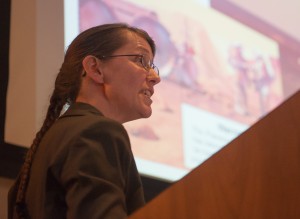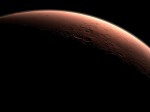
The idea that Mars is home to alien biology has fascinated writers and researchers alike since H.G. Wells published his seminal Martian invasion novel, “The War of the Worlds”, in 1898. However, scientists who study the planet have by and large focused on the possibility that Mars hosted life in the distant past, since the chance of present-day life seems slim.
About 35 astrobiologists, chemists, physicists, geologists and policy makers presented research during the Present-Day Habitability of Mars Conference co-hosted by UCLA’s Institute of Planets and Exoplanets.
The speakers represented the National Aeronautics and Space Administration, the Jet Propulsion Laboratory and a variety of national and international institutions. Their results suggest that Mars might be more habitable than previously thought.
“We know ancient Mars was interesting because there was liquid water,” said Charles Cockell , a professor of astrobiology at the University of Edinburgh and co-convener of the conference. “But people have tended to write off present-day Mars as a possible location of life.”
David Paige, a professor of earth and space sciences who helped organize the conference, said he aimed to inspire conversation and cooperation among a wide variety of scientists focused on investigating the red planet’s present-day environment.
He said that similar conferences tend to be large and unfocused, inhibiting cross-discipline collaboration.
To thoroughly investigate another planet, scientists need to understand the Martian planet from the reaches of its upper atmosphere to its sub-surface environment, thought to be a possible home for Martian microorganisms.
NASA sent the first spacecrafts to Mars in 1975. Twin robots Viking 1 and 2 analyzed Martian soil and atmosphere, conducting life-detection experiments that were ultimately inconclusive.
Since then, five rovers have landed successfully and collected information about the Martian geology, geography, atmosphere, soil and general environment.
Curiosity, the most recent rover, landed last August with the most capabilities of any Martian rover to date. Its goal is to locate and investigate ancient Martian habitats. NASA announced in December that it would send another rover in 2020 to investigate the present-day capability of Mars to sustain life.
However, this week’s conference focused mostly on results from the Phoenix lander, which launched in 2007. Phoenix found evidence of molecules called perchlorates, a kind of salt, before it lost contact with Earth in 2008.
Perchlorates are particularly important for three reasons.
For one, they could explain why the Viking landers did not detect organic molecules in the Martian soil. These salts can destroy organic matter at the high temperatures of the Viking experiments, Cockell said.
Second, perchlorates reduce the freezing temperature of water. Liquid water is thought to be necessary – or at least highly important – to the existence of life. Since the surface of Mars is below freezing and its atmosphere very dry, perchlorates have the potential to keep water liquid under conditions that would otherwise be too extreme to support life.
Third, a few Earth bacteria can use perchlorates as an energy source, indicating that if microbes did exist on Mars, these salts could be a food source.
In addition to the results from Phoenix’s data, Ashwin Vasavada, deputy project scientist of the rover, discussed recent results from Curiosity, which boasts ten instruments built to explore the Martian environment.
“Mars is a really fascinating place,” Vasavada said. “There are even signs that liquid water may be coming out on (the) surface today. So it’s possible Mars is habitable.”
Vasavada’s interest in planetary exploration was sparked by photos from the Viking landers as a child.
“I was blown away by the fact that these pictures were other worlds no one in history had ever seen before,” he said.
As a senior at UCLA in the early 1990s, he found a flyer advertising a planetary science class taught by Paige. The course set him on his path toward his career in space exploration.
The results presented at the conference have implications for the direction of both planetary science and planetary policy.
Catharine Conley, NASA’s planetary protection officer, chaired the last session of the conference. Conley and other speakers gave an overview of current policy regarding interplanetary exploration and the legal ethics of sending spacecraft or humans to space objects potentially home to life, like Mars and Europa, Jupiter’s moon.
“But what do you do when an astronaut gets sick (on another planet)?” Conley asked the crowd as she concluded her presentation.
Still, it seems Conley and the rest of the international space community have some time to develop such protocol.
Both Vasavada and Paige said it remains difficult to predict whether humans will ever colonize Mars, let alone travel there in the next decade.
“If you want to send a person to Mars, you’ve got to do it,” Paige said. “But robots are getting better and better, and human capability is stalled.”
At the end of the conference, Paige said he intends to publish a special journal focusing on the present-day habitability of Mars and hopes to reconvene the conference within the next five years.
Email Case at ecase@media.ucla.edu.
